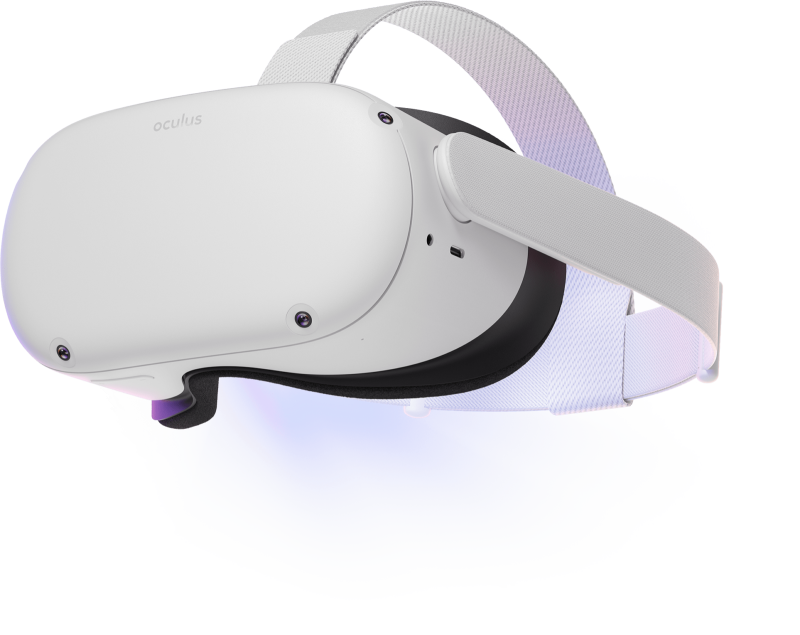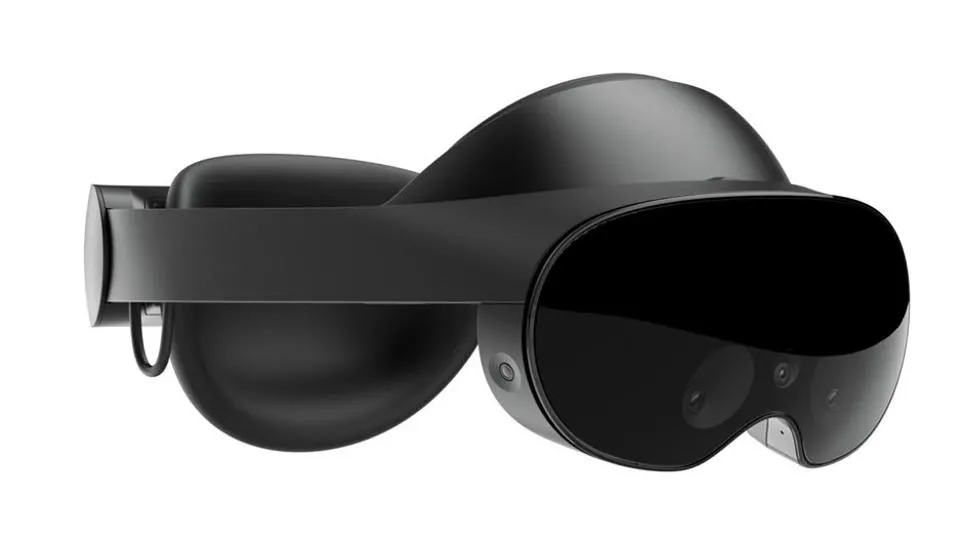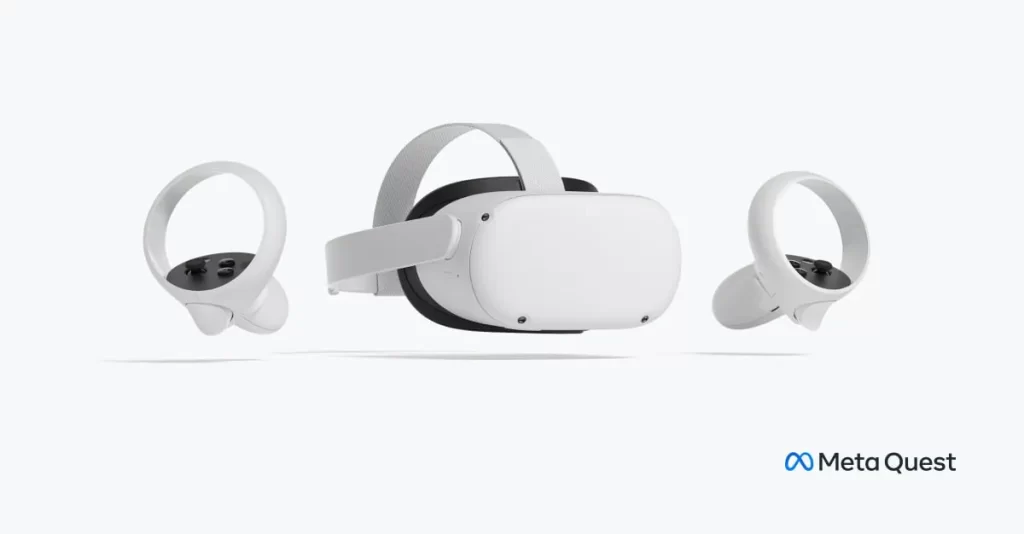Virtual Reality Gaming New Headsets You Must Have!
Virtual reality gaming continues to amaze with high quality new headsets hitting the market in 2023. The large form headsets we have had up until recently are now being replaced my super small but high-quality products Now. It’s time to review the world of virtual reality gaming once again to keep us all up to date! The market has continued to have exceptional products released with the popular mid tear Reverb G2 getting updates although still a super popular choice if you’re on a budget.
One of the most anticipated new virtual reality gaming headsets is the offering from BIGSCREEN VR. Recently released this has shown us how you can make an incredibly good VR HMD that is super small. It delivers as much as the previous large designs in a small form factor so let’s look at this and the selection of choices, we have in 2023 and beyond!
The Latest Gaming VR Units.
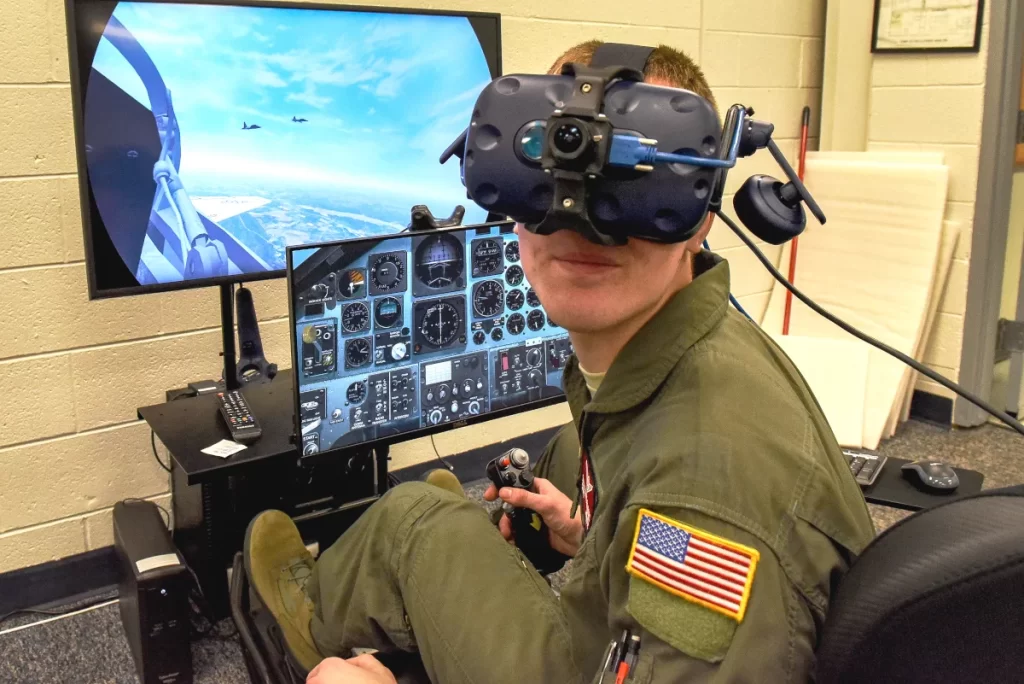
- Meta Quest 3 – $499 USD (Available Now)
- Big Screen VR – $999 (Coming Jan 24)
Best of the Rest VR HMDs.
- HP Reverb G2 ($525 USD).
- HTC Vive Pro 2 ($1584 USD HMD + Tracking Stations – Controllers.
- Pico 4 (Stand alone Unit – Chinese Market Currently.
- Meta Quest Pro. (938 USD – Stand alone plus Mac/PC)
- PSVR2 $(549 PS5 Only)
- Meta Quest 2 – $299 (128 Gb) – $399 256 Gb (Hand Tracking)
- Meta Quest 3 – $299 (128 Gb)
- Valve Index. $1402 USD ( HMD – Controllers – Light Stations)
- DPVR – E4 – $599 USD
- Pimax Crystal – $1500
2023/24 HMD Releases.
It’s an exciting year with the recent Meta Quest 3 VR headset coming to the market and the very impressively as well as super small Big Screen VR unit due early 2024. If you’re in the market, there are a plethora of choices from inexpensive to premium top end models throughout the market but these two are the most recent options. But before we dive into specifications of these units there are a number of features you should consider making the best choice for you.
- Latest CPU’s Available Now – Amazon.com
- Get a NEW GPU Best Performance – AMAZON.com
- Upgrade RAM Here today – AMAZON.com
- Prebuilt PC Options – AMAZON.com
VR Headset Options.
There are several options you should consider in your virtual reality gaming headset or HMD (Head Mounted Display. There are traps for new players homing to secure a new VR gaming headset so let’s look at them.
- PC/MAC – Stand Alone – Tethered Unit.
- Resolution / PPD – Pixels Per Degree.
- FOV – Field Of View.
- Refresh Rate.
- Display Type.
- VR Lense Type.
- Tracking type : Inside Out with Cameras / Individual tracking Units.
- IPD Adjustment: Manual or Software IPD. (Interpupillary distance)
- Tethered / Nontethered.
PC/MAC – Stand Alone – Tethered Unit.
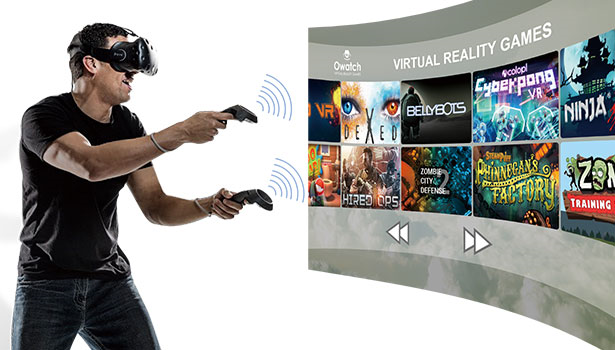
It’s very important to understand the many virtual reality gaming headsets are aimed at very different applications. There are professional and home stand alone units that do not require a PC to work. These often cannot play PC games or applications unless they have a cable tether. In saying this there are some that can be tethered to a PC and play games so it’s important before anything else to understand what you want to do with it. If you’re planning to play DCS World or MSFS/X Plane, then there are some virtual reality gaming sets you should avoid at all costs. As always if you’re not sure ASK!
Ther Playstation and other game consoles also have specific headsets that can be used with them, and they are generally not cheap. Often if there is a lot of marketing mentioning 128 or 256 GB Ram then it’s likely a standalone unit with only specific games that the manufacturer can supply through the internet,
Resolution / PPD – Pixels Per Degree.
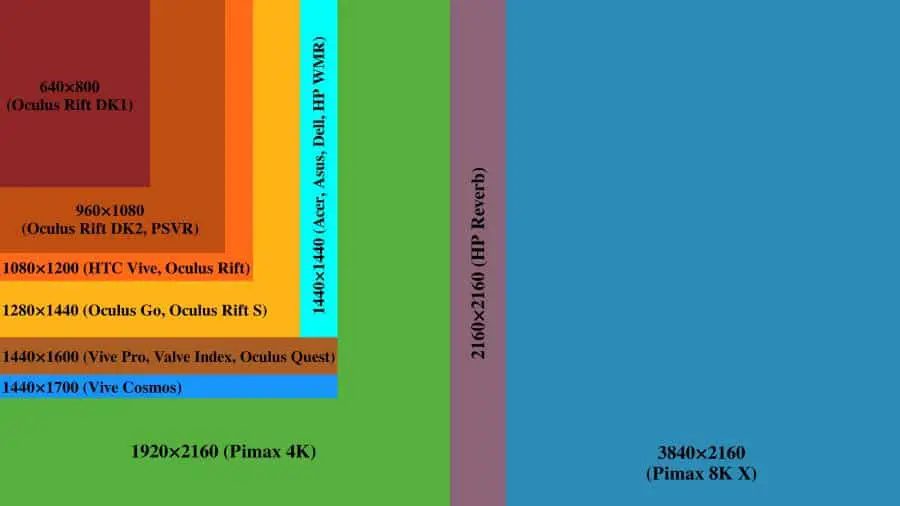
Resolution is a measurement on how many pixels both vertical and horizontally are available per eye. It’s important to understand if the headset has two individual screens, i.e. one per eye or there is a single display which uses half for the left and half the display for the right eyes view. Often manufacturers will just give you an overall display number like 1080 * 1920 which is standard full HD. This would actually be a poor resolution for two eyes where it would be divided in half.
A second way of explaining the resolution of the display is PPD – “Pixels Per Degree.” This tells you how many pixels per degree of your display are visible. Again, is this for the whole display or individual displays?
The figure above shows historically the resolutions available for the most popular virtual reality gaming headsets. It does not include the most recent but as a guide will give you something to work from.
FOV – Field of View.

Field of view is also an important factor with how much you can see in your headset before catching the edges of the display. I personally have the Oculus now META Rift S headset with 90 degrees field of view. I have to say I have never noticed I’m wearing a headset flying in X Plane 11/12 or DCS World flying.
I enjoy flying DCS PVP servers which I do a lot and never notices a problem. It’s never been an issue and I’m not sure it is a massive problem. There are headsets with massive FOV that may give a better experience, but humans look at the centre of the screen primarily and the edges only when you catch movement in the corner of your eye.
The figure above will give you a general idea of what each FOV offered gives you when you’re in your favourite VR headset. I’m sure a wider FOV would be great along with the highest resolution, but this will come at quite a cost to your budget. If your budget is not an issue, then shop away and get the very best and you will be amazed.
Refresh Rate – Is it Important?

Along with resolution and FOV there is a third factor that determines your virtual reality gaming experience plus how smooth it will be. This is refresh rate of your display screen so as in a computer monitor the more the refresh rate is the more FPS can be displayed ensuring a smooth delivery of frames. The frame rate has to be consistent, or you will have a stuttering display causing you loss of immersion as well as making many VR players somewhat sick.
The virtual reality gaming headsets above give you an idea of what’s been the norm so far. Newer VR headsets are starting to get even higher refresh rates as new hardware from AMD and NVIDIA have shown they can deliver the best VR experience and use higher refresh rates to deliver it. You absolutely need a powerful VR Computer to get the very best from this gaming environment.
Why is VR so TAXING on my PC?
You may be asking “Why is it so hard to get great FPS in VR?” If your new to VR then you know there are two slightly different pictures being displayed to give you the 3D stereoscopic depth effect, you see. This requires the computer to have a strong CPU & GPU to deliver two individual frames simultaneously. Yes, they are on small screens, but the resolutions are the same as two monitors in front of you but tucked into a head mounted display (HMD). So yes, the PC has to do twice the work to deliver your VR experience.
If you play a game/Simulator and get 60 fps on a monitor, then you’re probably going only to get half the FPS delivered to your virtual reality gaming headset. Hence you often need to reduce some settings to get back to a good smooth stutter free experience. Its not always a big change so let me give you an example of the differences. on my own gaming rig which is a moderate Ryzen 5600x with an NVIDIA 3070 plus SSD and 32 GB Ram I can fly over cities in X Plane 12 at maximum graphics settings. Yes, absolutely maxed in 1080P with no issues and get a solid 60 -70 FPS.
The with a low frame delivery time of less than 20 m/s. Doing the same flight in VR requires some changes to get a displayed FPS of 40 and a frame delivery time of 30 m/s. Yes the frame time is a bit higher than ideal but it is super consistent so I don’t get the jitteriness I would get if it was jumping from 20 to 40/50m/s when I look around.
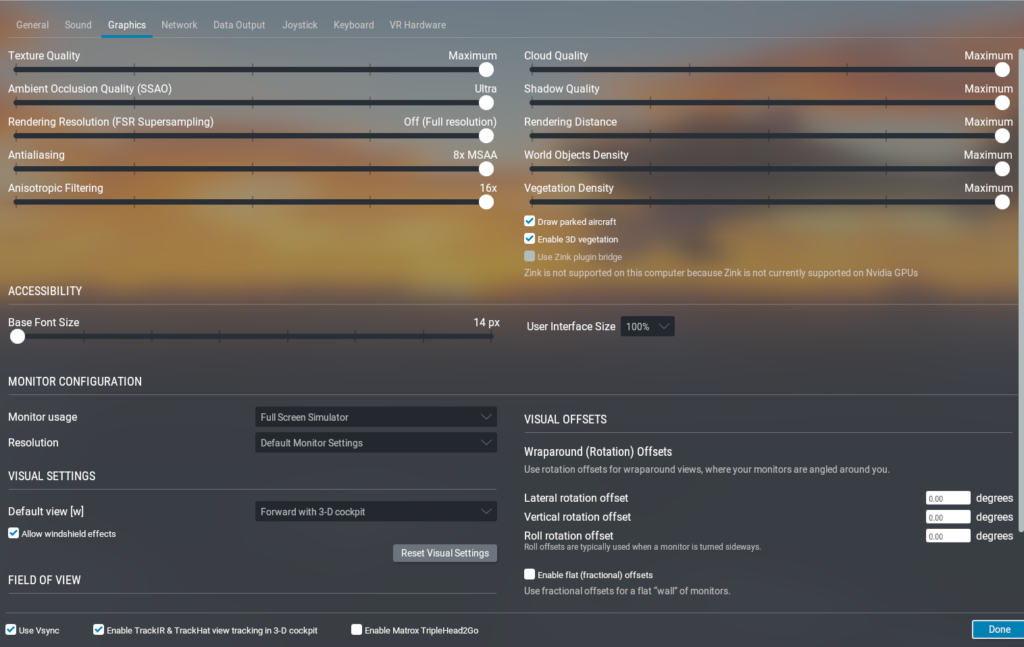
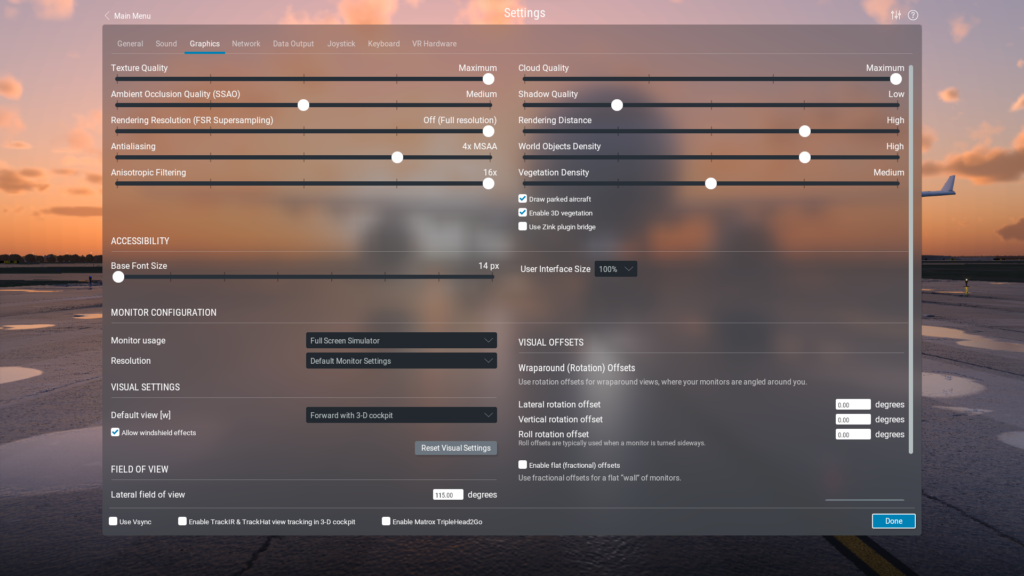
The settings above are my actual X plane 12 graphics settings so you can compare them. It may help you understand what you need to do to improve your overall experience.
NEW TOYS ON THE BLOCK.
Lets start with the two newest virtual reality gaming headsets on the market for you to compare with the:
- Meta Quest 3 – $499 USD
- Big Screen VR – $999
Meta Quest 3
Available Now
Big Screen VR
(Available Jan 2024)
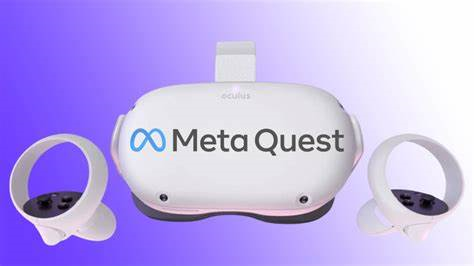
- meta.com
- Standalone VR
- $499 with controllers
- 128 GB model. 512 GB model: $649

- bigscreenvr.com
- Stand Alone VR
- $999 headset only
- Pancake lenses
- Pancake lenses
- 58-71 mm hardware adjustable (manual)
- Dual 18 PPD colour passthrough cameras
- 2 x LCD binocular
- 2064×2208 per-eye
- 120 Hz
- 25 PPD
- 55-72 mm
- 2 x Micro-OLED binocular
- 2560×2560 per-eye
- 90 Hz / 75 Hz mode available
- 32 PPD
- 2 x Steam VR 2.0 Tracking
The Meta Quest 3 is a light unit at only 155 g with head strap and includes a USB Type C Cable to connect to your PC as well as Wireless Connection via your local network. Powered by its own Qualcomm Snapdragon XR2 Gen 2 CPU.
The unit has 8GB of internal ram with 128 GB of storage and higher levels also available. It uses its own internal cameras giving 6 DOF Marker-based tracking for excellent accuracy. Sound comes from its own quality stereo speakers located in the headset.
The Big Screen VR uses your PC for its horsepower connecting with a USB Type-C connector and requiring both a DisplayPort 1.4 and 2 x USB 3.0 ports. Positional tracking requires two 2 x Steam VR 2.0 towers or light stations for 6 DOF headset tracking.
Big Screen VR will scan your face when you order to create a personalized face pad for great fitting. It also has an additional addon audio strap/speaker for impressive audio (Add $129 USD) Ordered Separately.
The Virtual Reality Gaming Headsets.
VR headset specifications comes from VRcompare – The Internet’s Largest VR & AR Headset Database (vr-compare.com)
HP Reverb G2
$525 USD
HTC Vive Pro 2
$1584 USD
Pico 4 Pro
Chinese Market Only ATM
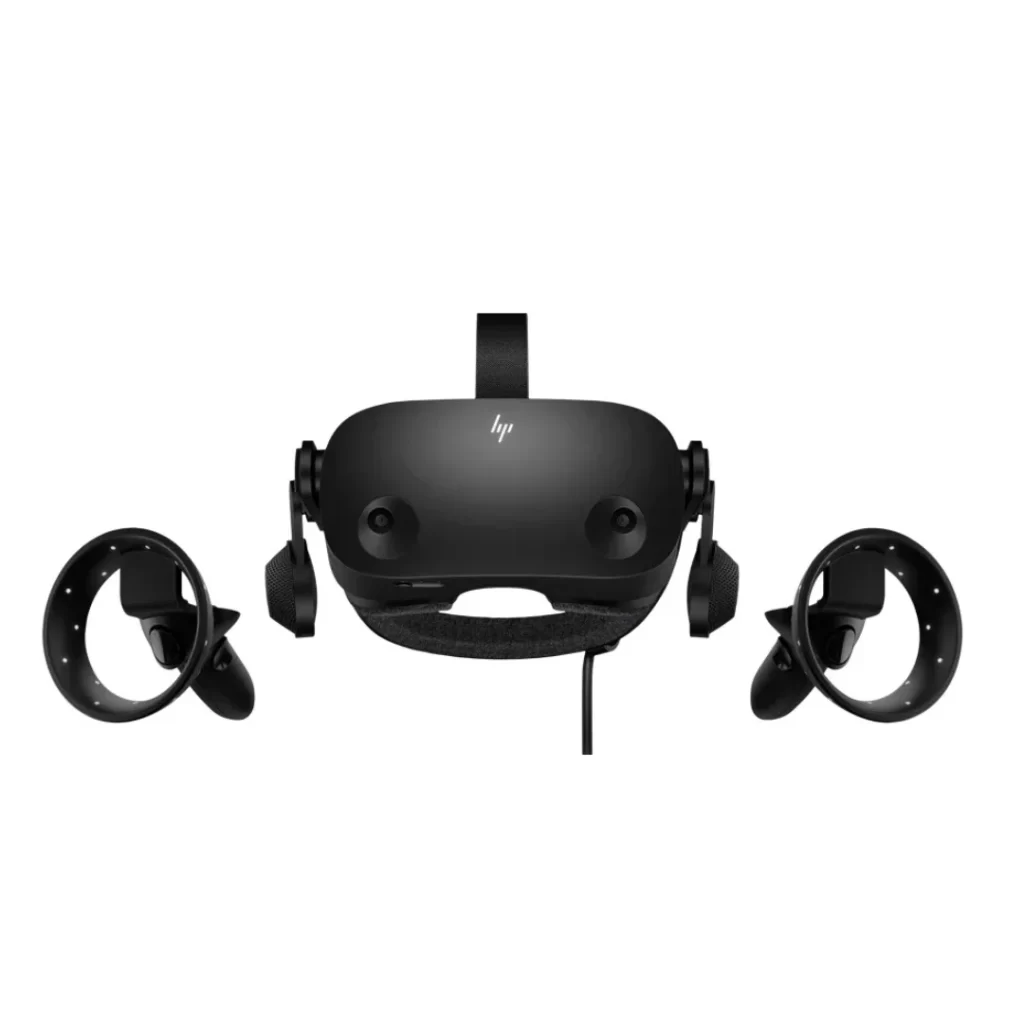
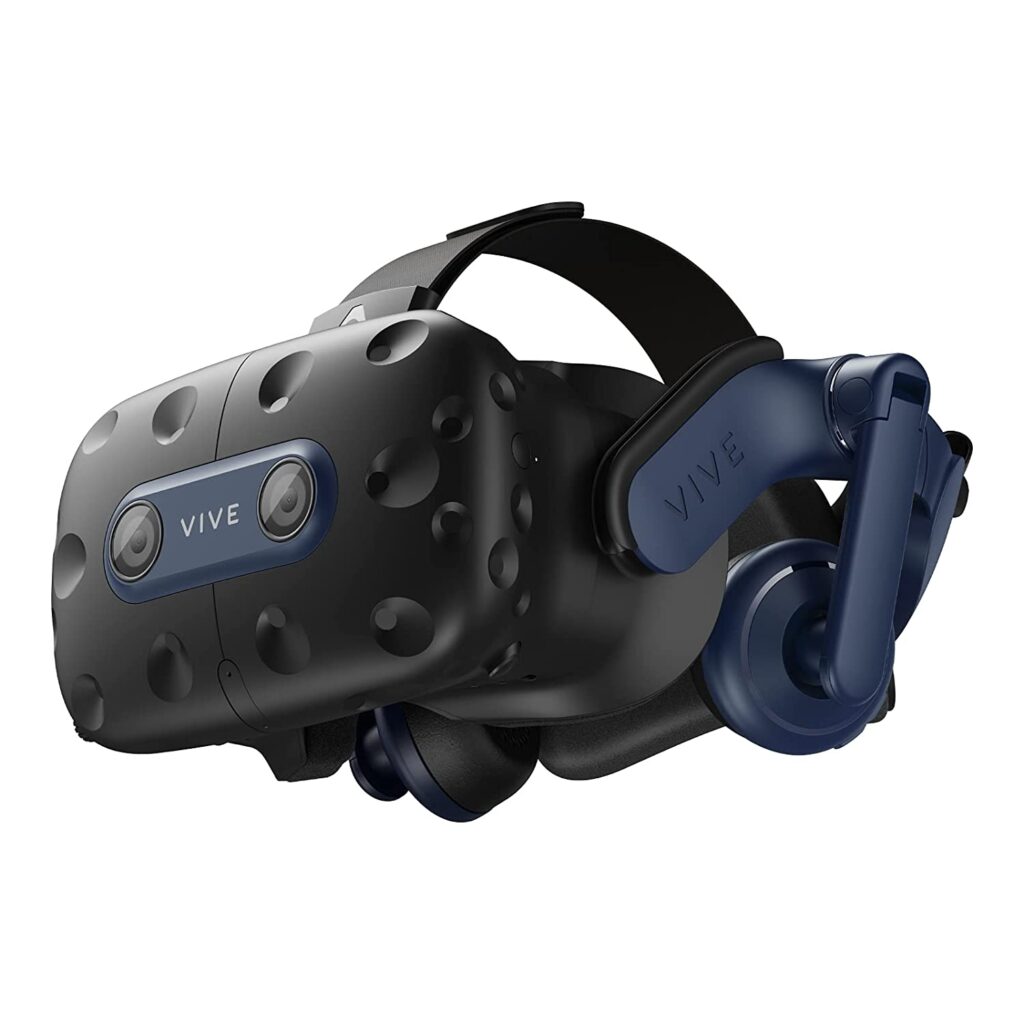

- hp.com
- $599 with controllers
- 2 x LCD binocular
- Fresnel lenses
- 6 DoF Inside-out via 4 integrated cameras
- 60-68 mm hardware adjustable (manual)
- 2160×2160 per-eye
- 98° horizontal
- 498 g with head strap
- DisplayPort 1.3, USB 3.0
- vive.com
- $1584 with controllers, base stations
- Dual-element Fresnel lenses
- 57-70 mm hardware adjustable (manual)
- Dual passthrough cameras
- 2 x LCD Screens binocular
- 2448×2448 per-eye
- 116° horizontal
- 850 g with head strap
- DisplayPort 1.3, USB 3.0
- picoxr.com
- Standalone VR
- Pancake lenses
- 62-72 mm hardware adjustable (automatic)
- 16MP RGB camera (Passthrough)
- 2 x LCD binocular
- 2160×2160 per-eye
- 104° horizontal
- 295 g without head strap
- USB Type-C / WiFi streaming
- meta.com
- $938 with controllers
- Pancake lenses
- 55-75 mm hardware adjustable (manual)
- Color passthrough
- 1800×1920 per-eye
- 90 Hz
- 108° horizontal
- 22 PPD
- 722 g with head strap
- 6 DoF Inside-out via 5 integrated cameras
- USB Type-C / WiFi streaming
- Mets.com
- 832 x 1920 Resolution Per Eye
- 60, 72, 90 Hz Refresh Rate Supported
- 128GB | 256GB
- 6 DoF Inside-out via 4 integrated cameras
- Fresnel lenses
- 58-68 mm hardware adjustable (manual)
- Single Fast switch LCD binocular
- 1832×1920 per-eye
- 120 Hz
- 97° horizontal
- 503 g with head strap
- USB-C – Oculus Link / Wifi Direct
- meta.com
- $499 with controllers
- 128 GB model. 512 GB model: $649
- Pancake lenses
- 58-71 mm hardware adjustable (manual)
- Dual 18 PPD color passthrough cameras
- 2 x LCD binocular
- Dual 18 PPD color passthrough cameras
- 2064×2208 per-eye
- 120 Hz
- 110° horizontal
- 25 PPD
- USB Type-C Oculus Link – Wifi Link

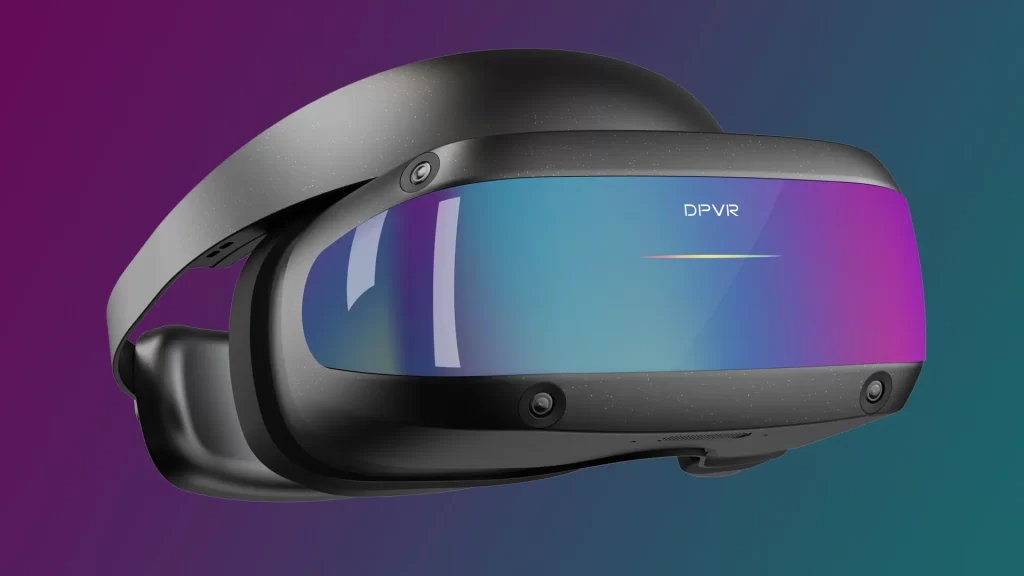
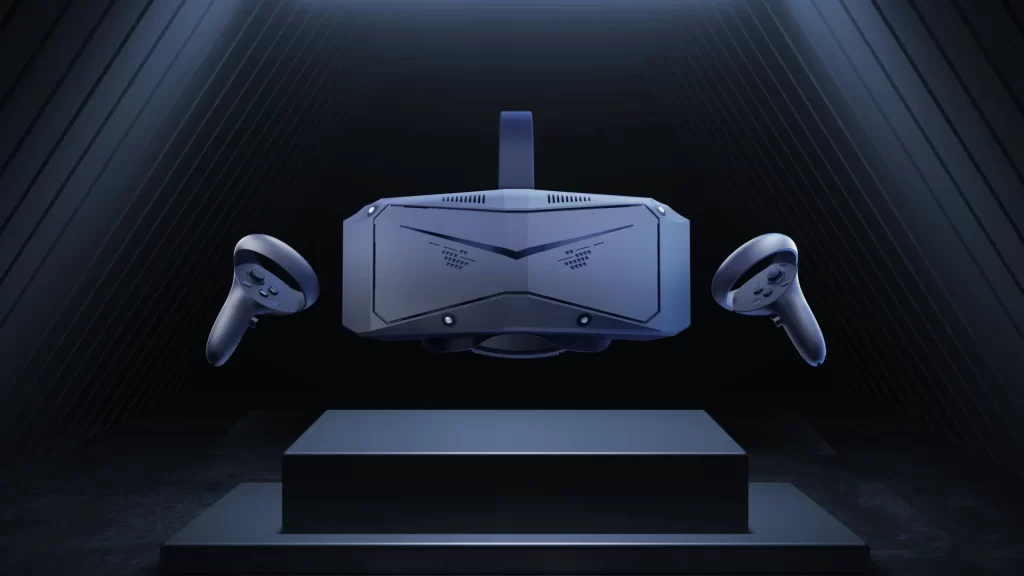
- valvesoftware.com
- $1402 with controllers, base stations
- Dual-element canted Fresnel lenses
- 58-70 mm hardware adjustable
- Dual 960×960 passthrough cameras
- 1440×1600 per-eye
- 144 Hz
- 108° horizontal
- 14.84 PPD horizontal
- 809 g with head strap
- 6 DoF Marker-based
- 2 x SteamVR 2.0 Base Stations
- Front USB port / DisplayPort 1.2, USB 3.0
- DPVR.com
- Fresnel lenses
- 3664 x 1920
- 116 Deg FOV
- 120 Hz Refresh Rate
- Inside-Out 6 DoF Tracking
- 280g Light Weight
- Virtual Reality Headset for PC,
- Support SteamVR Games
- 54-74 mm software adjustable
- Single LCD binocular
- pimax.com
- Standalone VR
- $1799 with controllers
- Aspheric lenses / Glass lenses
- 58-72 mm hardware adjustable (automatic)
- QLED binocular
- Local dimming, advertised as “HDR”
- 2880×2880 per-eye
- QLED binocular – Local dimming, advertised as “HDR”
- 160 Hz 90 Hz, 120 Hz, 144 Hz modes available.
- 110° horizontal
- 42 PPD
- 845 g with head strap
- USB / Display Port
- WiFi / WiGig streaming* – WiFi 6E
Lenses Make a Huge Difference!
Fresnel lenses, dual-element canted Fresnel lenses, pancake lenses, aspheric lenses, and glass lenses are all types of optical lenses, each with its own design and performance characteristics. Let’s explore the differences between them:
- Fresnel Lenses:
- Design: Fresnel lenses are flat and thin optical lenses that are made up of a series of concentric grooves or ridges. These grooves can be thought of as a series of prisms, and they diffract light, focusing it like a traditional curved lens.
- Performance: Fresnel lenses are lightweight and thin, making them suitable for applications where space and weight are critical. However, they may suffer from optical imperfections like reduced image quality due to diffraction effects.
- Dual-Element Canted Fresnel Lenses:
- Design: These lenses consist of two separate Fresnel elements that are slightly tilted or canted relative to each other. The canted design helps reduce some of the optical imperfections associated with traditional Fresnel lenses.
- Performance: Dual-element canted Fresnel lenses aim to improve optical quality compared to single-element Fresnel lenses. They are often used in applications where a compromise between performance and thickness/weight is necessary.
- Pancake Lenses:
- Design: Pancake lenses are characterized by their extremely compact, flat, and thin design. They often use aspheric lens elements to correct for optical aberrations.
- Performance: Pancake lenses are ideal for compact and lightweight camera systems. They typically have good optical performance due to the use of specialized glass elements or aspheric designs. However, they may have limited zoom capabilities or lower light-gathering ability.
- Aspheric Lenses:
- Design: Aspheric lenses have a complex, non-spherical shape, which allows them to reduce optical aberrations and maintain better image quality across the frame.
- Performance: Aspheric lenses are designed to correct aberrations such as spherical and chromatic aberration. They can provide superior image quality with reduced distortion and increased sharpness. These are often used in high-end camera lenses and precision optical instruments.
- Glass Lenses:
- Design: Glass lenses are typically made from conventional optical glass and can have a spherical or aspheric design. They come in various shapes and sizes, depending on their intended application.
- Performance: Glass lenses can offer excellent optical performance when properly designed and manufactured. They are versatile and can be used in a wide range of optical systems, from eyeglasses to camera lenses to telescopes. The choice of glass material and coatings can greatly affect their performance.
The choice between these lenses depends on the specific requirements of the optical system and the trade-offs between factors like size, weight, cost, and optical performance. Aspheric and glass lenses are often preferred when image quality is paramount, while Fresnel lenses and pancake lenses are more suitable for applications where size and weight constraints are critical. Dual-element canted Fresnel lenses aim to strike a balance between optical performance and thickness.
Conclusion.
The virtual reality gaming VR headsets are quite different in design with different lense and screen options plus range of varying resolution options. The tracking options with inside out using built in cameras make headsets cheaper as the Steam Stations are expensive at about $600 USD a pair. Cost really is the overall driver to choices. If you have a big budget and a powerful PC then the most expensive choices are the ones to dive into. The 5-700 USD range has some quality CR units that most will enjoy in their daily gaming exploits. I hope this overview can help you discover the best answer for your own needs.

Author.
Brendon McAliece is a multi-lingual expat who brings over three decades of flight simulator/PC building experience as well as over two decades of real-world jet fighter experience as a weapons/egress technician.
He holds a sport pilot certificate giving him real-world flying experience. His travels have taken him from Europe to the Middle East, Asia and his home of Australia. He has a passion for travel, languages, Flight simulation as well as Guitaring and Coffee. You can read more in his blogs below.
Learn More @ DreamingGuitar.com – DreamingCoffee.com – LetsFlyVFR.com
( HOME – BLOG – SHOP – ABOUT )
As an Amazon affiliate I may benefit from qualifying sales.
